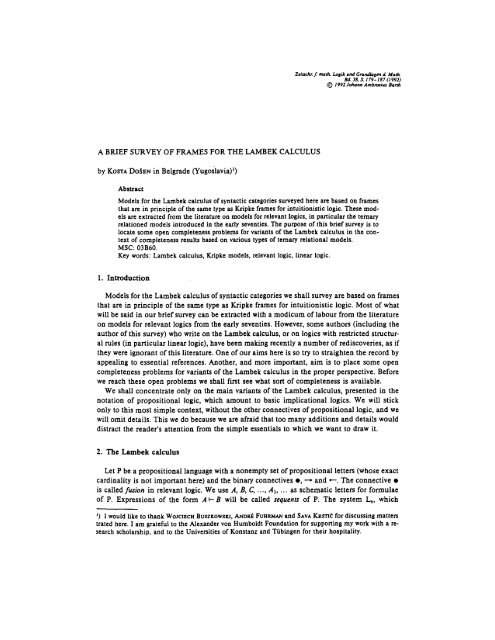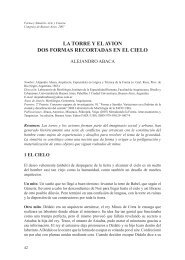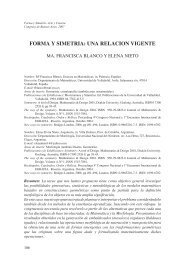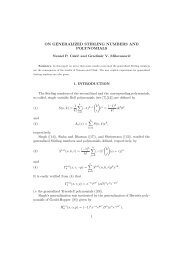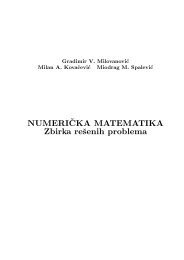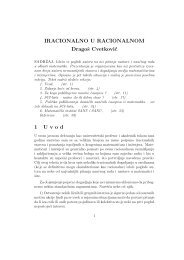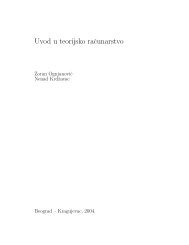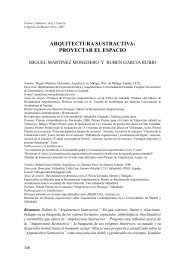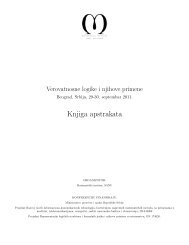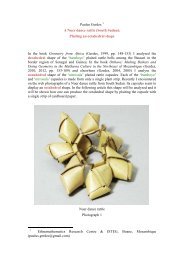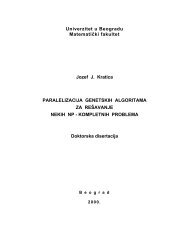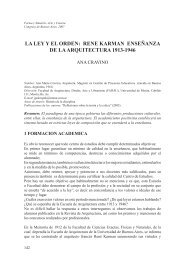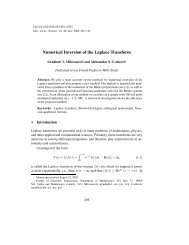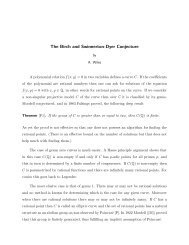A BRIEF SURVEY OF FRAMES FOR THE LAMBEK CALCULUS
A BRIEF SURVEY OF FRAMES FOR THE LAMBEK CALCULUS
A BRIEF SURVEY OF FRAMES FOR THE LAMBEK CALCULUS
- No tags were found...
Create successful ePaper yourself
Turn your PDF publications into a flip-book with our unique Google optimized e-Paper software.
Analogously to Proposition 1 we can prove the followingA <strong>BRIEF</strong> <strong>SURVEY</strong> <strong>OF</strong> <strong>FRAMES</strong> <strong>FOR</strong> <strong>THE</strong> UMBER <strong>CALCULUS</strong> 181Prop o s it i o n 2. The sequent A I + A2 is provable in L, [ respectiuely L J iff for euery valuation uon euery ternav frame that satisfies (ass) [respectiuety (ass) and (corn)] we have u(A,) E u(A,).Models based on ternary frames with conditions as above have been introduced for variousrelevant logics by ROUTLEY and MEYER in [19],(201, [21], and by MAKSIMOVA in [lS] (an introductorysurvey may be found in DUNN [9]). In particular, the systems in (191 cover some closerelatives of the Lambek calculus.4. Operational groupoid kames and closure groupoid framesAs a particular type of ternary frames we have operational groupoid frames ( W, ., Cl), whereW is as before a nonempty set, . is an arbitrary binary operation on W, and C1 is an arbitraryunary operation on the power set of W. Every operational groupoid frame is a ternary framewhere the relation Rxyz is defined by z E Cl(x ey}. The completeness of L,, with respect to arbitraryoperational groupoid frames and arbitrary valuations on them follows from the proofof Proposition 1. In the canonical frame of this proof, W, i.e. P, is a groupoid with the connective0, and for X E W the set CLY may be defined as (B: (3A E X) Et- A is provable inL”}.An operational groupoid frame (W, *, Cl) will be called a closure groupoid frame iff forevery X, Y S W the operation C1 satisfies:((211) xs Y*CLYE ClY,(C12)ClCLY E CLY,((213) XE CLY.A closed valuation on a closure groupoid frame is a valuation v that for every A of P satisfiesu(A) = Clv(A). It is easy to check that for closure groupoid frames and closed valuations uwe can prove:(v’+)(v’+)u(A+B)={x: (Vy~v(A))y.x~u(B)},u(B+A) = [x:(VYE u(A))x.y~ u(B)}.Actually, we do not use the full power of (C1 l)-(CI 3) to prove (v’+)ing weaker condition assumed for every X E W and every x, y E W:x.yEClXoCl[x.y}ECLYand (v’+). The follow-is necessary and sufficient with closed valuations. However, valuations need not be closed toget (v’+) and (v’ +); it is necessary and sufficient to assume that for every B of P and everyX, y E W they satisfyX - ~ v(B)oCl{x.y} EE u(B).Let X . Y = {x . y : x E X & y E Y) ; then, if C1 in a closure groupoid frame satisfies for everyx, YE w(C14)CIX-CIYS CI(X* Y),((215) CLY = b: (3x E X)y E Cl(X}},
184 K. DOSENositional constant T is definable in it by A+ A, for an arbitrary A. Of course, in Lh the connectives+ and +- are synonymous.A simple groupoid frame ( W, .) is a semilattice iff. is associative, commutative and idempotent.Let us call a valuation u on a simple groupoid frame multiplicative iff for every A of Pand every x, y E W we have(mult)XE u(A)=x.y~ u(A).For simple groupoid frames that are commutative semigroups it is enough to assume (mult)for every propositional letter A in order to infer by induction on the complexity of B that(mult) holds for every B of P; i.e. multiplicative valuations can be defined inductively. Withmultiplicative valuations u on semilattices we have:~(A+B)=u(B+A)={x:Vr((3y(x*y=~)& zEv(R))*zEu(B))},u(AB) = u(A) n u(B),which shows that our models are a kind of Kripke models for intuitionistic logic.Then we prove the followingProposition 3 . The sequent A l- A2 is provable in Lh ifl for every multiplicative valuation uon every simple groupoid frame that is a free semilattice we have v(AJ E u(A2).Proof. From left to right we proceed by induction on the length of proof of Al I- A2 in Lh.We need (mult) in this induction in order to show that u(A B) E u(A).To prove the other direction we first introduce the following terminology. Let a formula ofP be called prime iff it is not of the form B 0 C, and let a prime factor of a formula A be aprime subformula of A that is not in the scope of an +, or an +. Next, let [A] be the set ofall formulae B whose set of prime factors is identical with the set of prime factors of A (inother words, B is obtained from A by using the associativity, commutativity and idempotenceof the connective 0 binding the prime factors of A). It is clear that [A] = [B] impliesthat A l- B and B l- A are provable in Lb (the converse need not hold). Next, let [A].[B] bedefined as [A B], and let W= {[A]: A is in P}. It is clear that so defined is an operation,that W is closed under this operation, and that ( W, .) is a semilattice freely generated fromall the sets [A] such that A is prime. This ( W, -) will be our canonical simple groupoid frame,on which we define the canonical valuation u by u(A) = {[C]: CI- A is provable in Lh}. It isclear thatCl- A is provable in Lh iff (VB E [C]) B t- A is provable in Lh,ifT(3B E [C]) B l- A is provable in Lh.It remains to check that the canonical valuation is a multiplicative valuation. (For example,we use A 0 B t- A and A B l- B in order to show that from [C] E u(A B) it follows that[C]* [C] = [C],[C] E u(A) and [C] E u(B).) Then suppose that Al t- A2 is not provable in Lh;with the canonical valuation u on our canonical simple groupoid frame we have [A,] E u(A,)and [A,] e u(A2). 0Of course, an analogous proof shows that with multiplicative valuations, Lh is completewith respect to all simple groupoid frames that are semilattices, not necessarily free. Simplegroupoid frames that are semilattices are closely related to semilattice semantics ofURQUHART (24); but a significant difference is that URQUHART’S semilattices, taken as join
A <strong>BRIEF</strong> <strong>SURVEY</strong> <strong>OF</strong> <strong>FRAMES</strong> <strong>FOR</strong> <strong>THE</strong> <strong>LAMBEK</strong> <strong>CALCULUS</strong> 185semilattices, have a zero element. Without multiplicative valuations we obtain models for Lhminus A 0 B + A, which is a system related to the relevant logic R. In [24] URQUHART doesnot show completeness with the connective 0, and in the absence of principles correspondingto A 0 B I- A and A 0 B I- B his simple and elegant method (which could also be adapted forthe proof of our Proposition 3) seems to be blocked. Perhaps something like the method ofBUSZKOWSKI [6] could be applied for system with related to R.7. Two-dimensional ternary framesWe shall now consider the following special type of ternary frames (W, R), where, for anonempty set D, the set W is a nonempty subset of D X D, and R~ryz holds iff for somea, b, CE D we have x = (a, b),y= (b, c) and z= (u, c). Ofcourse, with our standard definitionof valuation on ternary frames, these frames, which we call two-dimensional ternaryframes, give rise to models for La. We get (ass) and, hence, models for L, if moreover we assumethat W is a transitive relation. We do not get (com) simply by assuming that W is a symmetricrelation, but if we assume that W is transitive and symmetric, and we assume more-over that for every A of P the relation u(A) is symmetric, then we get models for L,.Recently, ORLOWSKA, BUSZKOWSKI and VAN BEN<strong>THE</strong>M have considered models for the Lambekcalculus where, for an nonempty set D, we have W = D X D, and u assigns to every formulaof P a subrelation of W so that:(~”0) u(AoB)={(u, b):3c((u,c)~u(A)&(c, b)Eu(B))},(v”+)(v”+u(A+B) = ((u, b): Vc((c, a) E u (A)a(e, b) E u(B))},u(B+A) = {(u, b): Vc((b, c) E u(A)-(u, c) E u(B))}(see ORLOWSKA [18], VAN BEN<strong>THE</strong>M [2], 3.2.9, and VAN B ~ E [3], M 4.2; for similar conditionson valuations in two-dimensional modal logic, see, for example, KUHN [12] and referencestherein; cf. also the definition of residuation in terms of conversion, composition and complementationin BIRKH<strong>OF</strong>F [4], XIV, 0 14, from which (v”-+) and (IT”+) can be inferred).These models amount to models based on two-dimensional ternary frames whereW= D x D, since from our standard definition of valuation on ternary frames we can infer(v”.), (v”+) and (v”~). In these two-dimensional ternary frames, W is, of course, transitive,and hence we have frames for L,. However, L, cannot be complete with respect to theseframes since with them for every valuation u we have(*I u(A) E u(A o(B4B)) and u((B+B)-+A) E u(A),whereas neither A I- A 0 (B+ B) nor (B+ B)+ A I- A is provable in L,. We are able toprove the inclusions of (*) because W is a reflexive relation; if we do not want (*), we shouldnot have the reflexivity of W8. The Lambek calculus with TThough the sequents A I- A 0 (B+ B) and ( B4 B) + A I- A are not provable in L,, theyare provable in a very natural extension of L,. Let Pt be the extension of the language P withthe propositional constant T and let L1, L,, and La be systems in PI obtained from the axiomatizationsof L, L, and L,, respectively, by adding the axiom-schemata:
186 LDOSENToAI-A,AoTI-A,AI-ToA,AI-AoT.The sequents A I- A 0 (B+ B) and (B- B)d A I- A are provable in L,,,,and a fortiori in ktand L. (That the second sequent is provable in a system that amounts to L,, was noted inBUSZKOWSK~ [6], 4.2.)Let now L, be I., L,, or La, and let us consider how we could formulate the (0, +, +)fragment of L. Gentzen-type sequent formulations of this fragment, which may also be cutfree,can easily be constructed by proceeding as in [8]. Via these Gentzen formulations wecan show that a Hilbert-type axiomatization of all formulae A of P (i.e. formulae in the connectives0, + and +) such that T I- A is provable in L may be obtained from our axiomatizationof L, by replacing every I- in the axiom-schemata and rules by + and adding therulesA+B B+A A A+BB+A’ A+B’ BWith this Hilbert-type axiomatization we have a rather good control over the (0, +, +) fragmentof L, since A t- B is provable in & iff T I- A+ B is. But, of course, if T I- C is provablein L,, then C is not necessarily of the form A+B (or B+A); for example, we canprove T I- (C1+ C,) 0 (C2- CJ in L,. An axiomatization of the (0, +, +) fragment ofgiven uniquely for sequents of the form A I- B may be obtained by extending L, with therulesA I- Bh(A I- B) I- h(C1 I- 01)0 ... 0 h(CnI- On)Cit- 0;(n 2 1 ,ls is n),where h (A, I- A2) is either Al + A2 or A2 + Al , and the bracketing on the right-hand side ofthe right premise is arbitrary. This can be inferred without much dificulty from our Hilberttypeaxiomatization, for which the rulesAoB AoB A BA ’ B ’ AoBare admissible, and where A B cannot be provable if A or B is a propositional letter.We shall not go here into considering models based on our frames for L,,,,L,, and L, andfor extensions with other connectives (indications on how to proceed may be obtained fromour references). Let us only note that in models based on two-dimensional ternary frames,u(T) will be the identity relation on 0, which is included in W if W is reflexive. We leave asan open problem whether any variant of the Lambek calculus we have considered is completewith respect to a certain class of two-dimensional ternary frames.References[I] ABRUSCI, V. M., Sequent calculus for intuitionistic linear propositional logic. In: MathematicalLogic (P. P. PETKOV, ed.), Plenum Press, New York 1990, pp. 223-242.[21 VAN BENIXEM, J. Semantic parallels in natural language and computation. In: Logic Colloquium ‘87(H.-D. EBBINGHAUS et al., eds.), North-Holland hbl. Comp., Amsterdam 1989, pp. 331-375.[3] VAN BEMHEM, J., Language in action. J. Philosophical Logic 20 (1991), 225-263.[4] BIRRH<strong>OF</strong>F, G., Lattice Theory. 3rd edition. American Mathematical Society, Providence, R.I., 1967.


